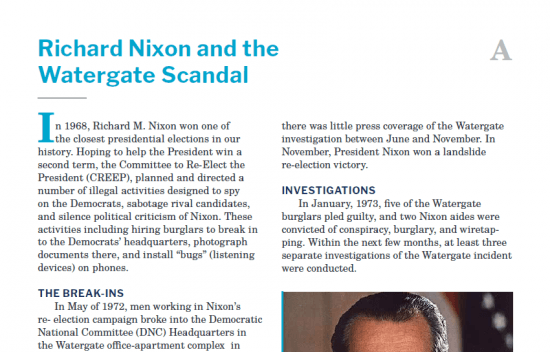



Nixon, Watergate, and Impeachment Playlist
18 items
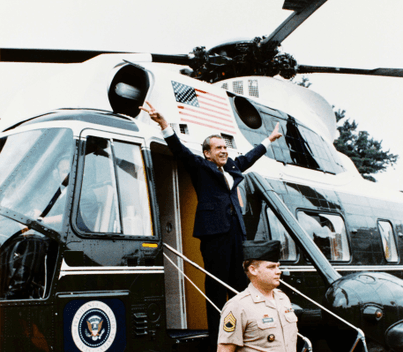
The Resignation of Richard Nixon
Lesson - 2 Activities
Lesson
2 Activities
50 Min
Shortly before Richard Nixon was re-elected President in 1972, individuals connected with his re-election campaign were arrested while breaking into Democratic Party Headquarters at the Watergate office complex in Washington DC. Nixon was re- elected by an overwhelming margin, but questions surrounding his knowledge of the break-in, and his attempt to cover it up would not go away. During these investigations, Nixon’s Vice President, Spiro Agnew, was forced to resign on unrelated corruption charges. According to the Twenty-Fifth Amendment, the President must nominate a new Vice President when that office becomes vacant, and both houses of Congress must approve that Vice President. Because few in Congress believed that Nixon’s presidency would survive, key members of Congress told Nixon to nominate as Vice President a distinguished Republican Member of Congress, Gerald Ford. After Nixon’s resignation, Ford was sworn in as President and made the extremely unpopular decision of issuing Nixon a full pardon “for all offences against the United States.”
50 Min

Richard Nixon and the Watergate Scandal
Lesson - 3 Activities
Lesson
3 Activities
50 Min
In 1974, Richard M. Nixon became the only President in US history to resign from the presidency. After administration operatives were caught breaking into the Democratic Party headquarters at the Watergate office complex in Washington, DC, Nixon covered up the crime. A Congressional investigation produced a stunning revelation: The Oval Office had a recording system that taped all the President’s conversations. The tapes could prove whether Nixon himself had ordered the cover-up. The Supreme Court rejected Nixon’s claim that executive privilege allowed him to withhold the tapes. With members of his own Republican Party turning against him and the House drawing up impeachment charges that were sure to pass, Nixon resigned the presidency on August 9. The events raised serious questions about the definition, use, and abuse of executive authority.
50 Min
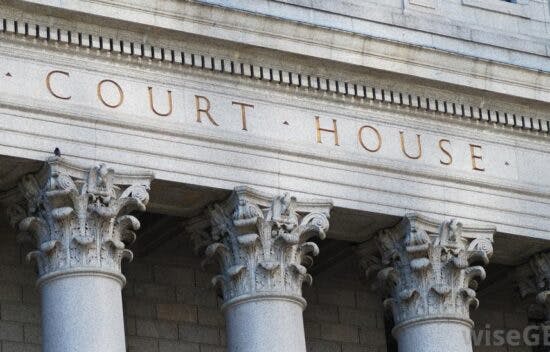
United States v. Nixon (1974)
Lesson - 3 Activities
Lesson
3 Activities
Case background and primary source documents concerning the Supreme Court case of United States v. Nixon. Dealing with the principle of separation of powers, this lesson focuses on the question of whether or not the Constitution’s separation of powers intended to create an absolute executive privilege.
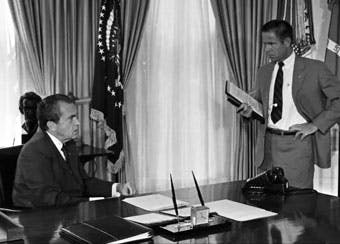
Nixon Tapes: The “Smoking Gun” Tape, 1972
Activity
Activity
40 Min
Use this primary source text to explore key historical events.
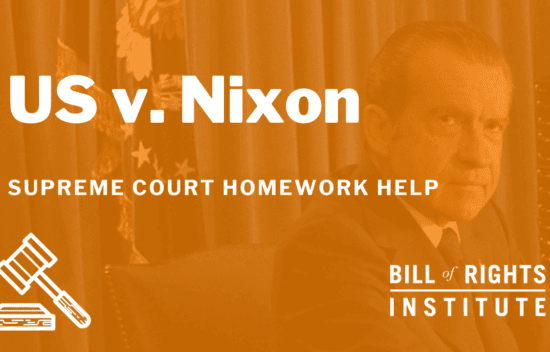
United States v. Nixon | BRI’s Homework Help Series
Video
Video
4 Min
Can the President of the United States withhold certain information from Congress and the courts? During the Watergate Scandal, President Richard Nixon attempted to withhold recording tapes from the White House from investigators. The Supreme Court’s ruling would have huge impacts on the system of checks and balances within the United States' governing system.
4 Min

Reading United States v. Nixon Case Excerpts
Video
Video
17 Min
Can the president of the United States withhold certain pieces of information from legislative and judicial oversight? In this episode of BRI’s Primary Source Close Reads, Joshua Schmid is joined by Dr. Josh Dunn as they break down excerpts from the case of United States v. Nixon relating to the question of executive privilege. How did the Watergate Scandal lead to this Supreme Court case? Is the president’s right to safeguard certain information entirely immune from judicial power?
17 Min

Gerald Ford, Watergate, and Separation of Powers | BRI Scholar Talks
Video
Video
26 Min
What actions to limit presidential power did President Gerald Ford take after the Watergate scandal and the resignation of Richard Nixon? In this episode of Scholar Talks, Dr. Alex E. Hindman, Assistant Professor of Political Science at the College of the Holy Cross, joins BRI Senior Teaching Fellow Tony Williams to talk about his book “Gerald Ford and the Separation of Powers: Preserving the Constitutional Presidency in the Post-Watergate Period.” Together, they discuss President Ford’s famous pardon of Richard Nixon, the effect of the War Powers Resolution on presidential powers, and how President Ford preserved the constitutional powers and limits of the presidency.
26 Min
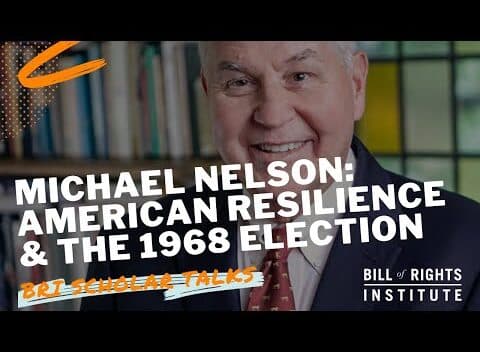
American Resilience & the 1968 Election with Michael Nelson | BRI Scholar Talks
Video
Video
23 Min
How did American institutions prove their resilience amid the tumultuous 1968 presidential election? In this episode of Scholar Talks, Michael Nelson, the Fulmer Professor of Political Science at Rhodes College and Senior Fellow at the UVA Jack Miller Center, joins BRI Senior Teaching Fellow Tony Williams to talk about his new book, "Resilient America: Electing Nixon in 1968, Channeling Dissent, and Dividing Government." Together, they discuss postwar American political trends, divisions in American society, and the candidates who ran. How did the 1968 presidential election lead to a divided government and how did it demonstrate the resilience of American institutions?
23 Min

New York Times Co. v. United States | BRI’s Homework Help Series
Video
Video
6 Min
How to best balance liberty and security has been a perennial question throughout U.S. history. This Homework Help video explores how the Supreme Court addressed this question in the landmark case of New York Times Co. v. United States.
6 Min
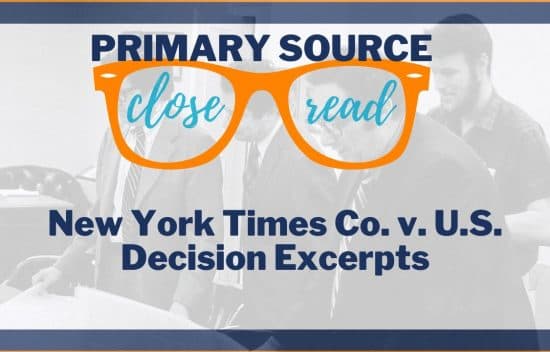
Reading New York Times Co. v. U.S. Decision Excerpts | A Primary Source Close Read w/ BRI
Video
Video
33 Min
In the midst of the Vietnam War, The New York Times released what the government considered to be highly sensitive information: the Pentagon Papers. In this video, Kirk Higgins and Joshua Schmid explore the Supreme Court case involving this matter, New York Times Company v. United States. How are we to balance the freedom of the press and our national security? To what extent can the government use its power of prior restraint to forcibly silence the press?
33 Min

Comparing Impeachments Across U.S. History
E Lesson
E Lesson
20 Min
Note: This lesson is adapted from materials contained in the Bill of Rights Institute’s forthcoming U.S. History resource entitled Life, Liberty, and the Pursuit of Happiness: A History of the American Experiment.

Impeachment Proceedings
E Lesson
E Lesson
20 Min
The process of impeachment was outlined in the Constitution when it was drafted in 1787. To date, 19 officials, including judges, cabinet members, senators, and presidents, have been impeached and stood trial.
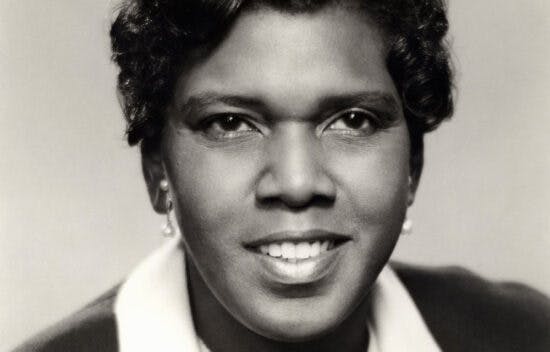
Barbara Jordan, Speech on Impeachment, July 25, 1974
Activity
Activity
40 Min
Use this primary source text to explore key historical events.
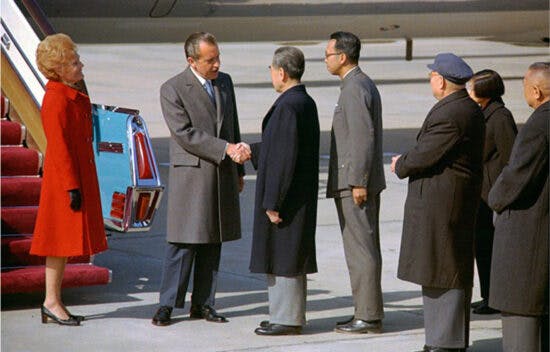
Richard Nixon Opens Diplomatic Relations with China
Essay - 2643 Words
Essay
2643 Words
Why did President Nixon visit China during the 1970s?
